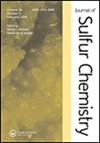制备含磺酸的功能化磁性纳米颗粒,作为合成苯并噻唑的有效可重复使用的固体酸催化剂
IF 1.6
3区 化学
Q3 CHEMISTRY, MULTIDISCIPLINARY
引用次数: 0
摘要
本研究在适当条件下制备了固体酸性磁性纳米粒子Fe3O4@SiO2-S-Bu-SO3H,并通过FT-IR、XRD、FE-SEM、EDX等多种分析技术对其进行了表征。本文章由计算机程序翻译,如有差异,请以英文原文为准。
Preparation of functionalized magnetic nanoparticles bearing sulfonic acid as an effective reusable solid acid catalyst for the synthesis of benzothiazoles
In this study, solid acid magnetic nanoparticles Fe3O4@SiO2-S-Bu-SO3H were prepared under appropriate conditions and characterized by various analytical techniques including FT-IR, XRD, FE-SEM, EDX, and VSM. Finally, the catalytic activity of the synthesized Fe3O4@SiO2-S-Bu-SO3H MNPs was investigated for the synthesis of valuable benzothiazole derivatives by the condensation reaction of ortho-aminothiophenol and various aldehydes under ultrasonic conditions. In the presence of the inexpensive, environment-friendly, magnetically recoverable solid acid catalyst, the benzothiazoles were obtained as pure target products in excellent yields (90–98%) and short reaction times (3–11 min). The synthesized Fe3O4@SiO2-S-Bu-SO3H MNPs show great catalytic activity because of the combined effect of Brønsted acidity and high functional group density. This solid acid magnetic nanocatalyst is reusable for several cycles and can be easily segregated from the reaction mixture.
求助全文
通过发布文献求助,成功后即可免费获取论文全文。
去求助
来源期刊

Journal of Sulfur Chemistry
CHEMISTRY, MULTIDISCIPLINARY-
CiteScore
4.10
自引率
9.10%
发文量
38
审稿时长
6-12 weeks
期刊介绍:
The Journal of Sulfur Chemistry is an international journal for the dissemination of scientific results in the rapidly expanding realm of sulfur chemistry. The journal publishes high quality reviews, full papers and communications in the following areas: organic and inorganic chemistry, industrial chemistry, materials and polymer chemistry, biological chemistry and interdisciplinary studies directly related to sulfur science.
Papers outlining theoretical, physical, mechanistic or synthetic studies pertaining to sulfur chemistry are welcome. Hence the target audience is made up of academic and industrial chemists with peripheral or focused interests in sulfur chemistry. Manuscripts that truly define the aims of the journal include, but are not limited to, those that offer: a) innovative use of sulfur reagents; b) new synthetic approaches to sulfur-containing biomolecules, materials or organic and organometallic compounds; c) theoretical and physical studies that facilitate the understanding of sulfur structure, bonding or reactivity; d) catalytic, selective, synthetically useful or noteworthy transformations of sulfur containing molecules; e) industrial applications of sulfur chemistry; f) unique sulfur atom or molecule involvement in interfacial phenomena; g) descriptions of solid phase or combinatorial methods involving sulfur containing substrates. Submissions pertaining to related atoms such as selenium and tellurium are also welcome. Articles offering routine heterocycle formation through established reactions of sulfur containing substrates are outside the scope of the journal.
 求助内容:
求助内容: 应助结果提醒方式:
应助结果提醒方式:


